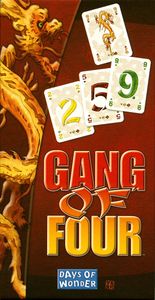The Dragon and the Phoenix.
This is Gang of Four.

BACKGROUND: Gang of Four is a card game for 3 or 4 players. It was initially developed in China by Lee Yih as a metaphor for the four powerful politicians that rose to power in China in 1966 to 1976, as well as previous rises in power. It was published in America by Days of Wonder in 1990.
GAMEPLAY: Every player is dealt a hand of 16 cards from the 64 card deck. Starting with the player who went out last, or the player with the multicolored 1 card, players go around playing combinations of cards in order to get rid of their hand first. Players may pass at any time, but may still play again when it comes to their turn.
TRICKS: Each time a player plays a "trick" or a card combination, it must be able to beat the previous numbers, beat matching numbers with colors. Yellow beats green, and A pair of red and green 2's can beat a pair of yellow 2's, but cannot beat anything higher than a pair of 2's. Poker hands like Straight or a Full House are some of the higher combinations, but a group of 4 cards, the titular Gang of Four, is the highest, and can only be beat by a higher Gang of Four.

SPECIAL: In the deck are 2 Phoenix cards and 1 Dragon. The Phoenix beats any numeric card, 2 Phoenix's beats any pair, and a Phoenix pair may only be in a group of 5 as a Full House. The Dragon beats any single card.
WINNING: Once a player has gone out, the other players count their cards, and score that many points times the scoring charts indicated number. For example, players with 8 cards will double to 16 points, and players with 16 will quintuple to 80 points. The first player to get to 100 points ends the game, with the player with the lowest score winning.
CONCLUSION: Gang of Four is a tricky game to review, as it has a significant place in history, and reviewing it would be like reviewing Chess or Go. However, Gang of Four is a pretty solid game, akin to games like Hearts or Cribbage. It's the kind of game you play with a group of friends who want a nice, slow game that's easy to understand but hard to master. That being said, this is the kind of game that you'd want to play with older friends, or your parents/grandparents. Gang of Four is a pretty good game, but not one that will click with a lot of people.






